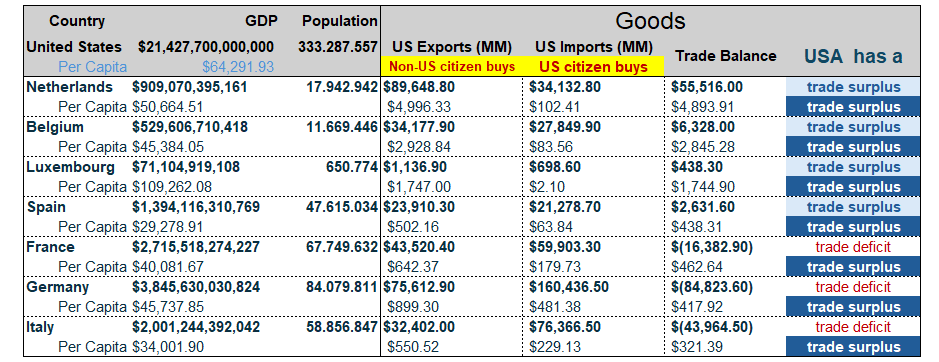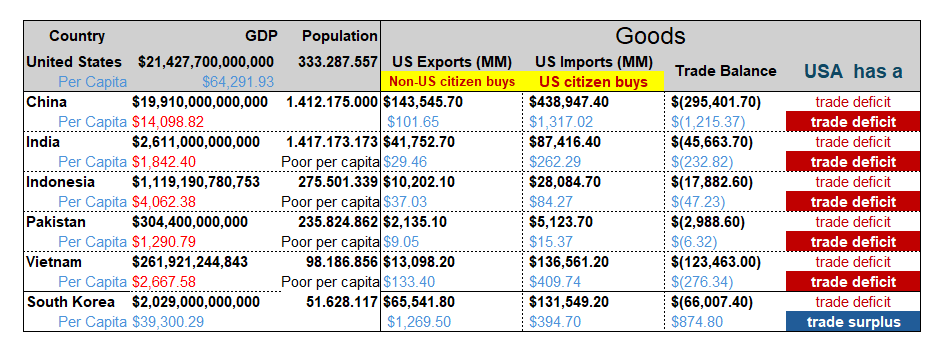Make America Attractive Again
Trump Tariffs are derived from US trade deficits. But are they really deficits? When looking into figures on a pro-capita basis, a whole new picture shows up and leads to surprising conclusions. An opinion piece
Paul
5/6/20257 min read


Trump Tariffs & US Trade Balance Deficits.
Are they really deficits?
Trump's by now (in) famous “reciprocal” tariffs have shaken up the world. Trumpenomics were applied to calculate tariffs with a never before seen formula by simply taking the goods trade deficit the US has with a given country, divided by the total goods from that country imported into the US, and divide that result by two. Trump’s main grievance is that (former) friend and foe have been freeloading and shamelessly taking advantage of the USA for decades. He summarizes this point of view by stating “they do not buy our cars, they do not buy our food”, a well known mantra by now. But is that really so?
Introducing 2 factors that impact trade deficits.
Population of any given country vs the USA population
Purchase power of the population of a given country
With these 2 in mind, let us examine Trump’s grievance that “they do not buy our products” and apply a "per capita" trade balance analysis (as opposed to country trade balance). That sheds a totally different light and in some cases leads to stunning conclusions.
And to be fully transparent, these are the data sources used: census.gov for trade balances and MS 365 Excel geography function for demographics and GDP. Without further ado, let's get to it.
America first
The USA has a population of well over 333 million people and boasts the world's largest country nominal GDP of 21.4 trillion USD (2024). Hence the GDP per capita is USD 64.290. The latter figure is a very rough indicator of purchase power, in this case of US citizens. The same approach will be applied to a series of countries to make things more comparible.
AMERICAS
Close Neighbours : Canada and Mexico


Canada
The US taken as a country undeniably has a 63 billion USD trade balance deficit with Canada. But when considering the very same data on a per capita basis it turns out that the US actually has a very comfortable trade surplus. In other words, in 2024 each Canadian purchased for 8974 USD American goods, whereas each US citizen only purchased 1238 USD in Canadian goods. Let this sink in: each Canadian bought about 7 times more US goods than his American friend just across the border bought Canadian goodies. So it is not fair to state “they do not buy our goods”. You simply cannot expect a nation with a population that is a fraction of yours to buy the same amount of goods. That is not rocket science but pure basics, dear Watson.
Mexico
In 2024, each Mexican, even with a much lower income, purchased 2619 USD in American goods, while US citizens bought 2520 USD in Mexican goods. True, the US trade deficit with Mexico is big in absolute figures. Part of that is due how US production supply chains are set up, importing parts from abroad to assemble the end product in the USA. Perfect example is the car industry as Elon knows…
EMEA - Non E.U.
UK and Saudi Arabia


UK
As demonstrated above, Americans only bought 204 USD worth of British goods, whereas the British purchased for about 1193 USD worth of US goods in 2024. The British bought 5.8 times more American goods than the Americans bought from the UK. Even with the UK having a much "smaller" population of nearly 67 million inhabitants, the USA (as a country) still has a hefty 11 billion USD trade surplus with the UK. Yet still Trump tariffs apply.
Saudi Arabia
The USA has a trade surplus with Saudi Arabia both on country basis and on per capita basis. This country is a strategically important ally to the USA, just like the UK, but notwithstanding this the country will be submitted to Trump Tariffs too. A logic that is hard to grasp. History in the making...
EMEA - European Union
Benelux - Spain - France - Germany - Italy


US trade balance surplus
The US maintains a trade balance surplus with Spain and all Benelux countries, i.e. Belgium, Netherlands and Luxembourg. Yet Trump's tariffs will apply to these countries too.
US trade balance deficits
The US also posts trade balance deficits (on goods) with countries like France, Germany and Italy. Yet on a per capita basis, individual inhabitants of each these countries still buy more US goods than Americans individually buy from these countries.
Germany: a summary case study
The US has a trade balance deficit with Germany of nearly 85 billion, yet in 2024 every German surprisingly purchased for about 900 USD of goods “made in America”, whereas Americans each bought just about 482 USD of "made in Germany" products. That is less than half of what each German pumped into the US economy. Again, this illustrates that a country trade balance alone does not tell the whole story.
APAC - Pacific Region
Australia, New Zealand and Japan


By now it should no longer be a surprise that we see the same phenomenon here too.
Per capita purchases of "Made in USA" products in Australia, New Zealand and Japan exceed by far what Americans bought in those countries. This clearly demonstrates that the argument “they do not buy our cars, machines or food” is leaking through every crack and does not hold water.
Japan - a closer look
A country like Japan with a headcount that is less than half that of the USA cannot be expected to match the purchase power of 333 million americans taken together. Not only that, the US has a GDP per capita of about 64 K USD, while Japan ends up much lower at about 40 K USD per person. This observation begs the question to what extent less affluent countries are able to manage -or not- unfavorable trade balances with the USA, and eventually end up in Trump's black book.
APAC - Asia
China, India, Indonesia, Pakistan, South Korea


In all fairness, Trump's arguments must not be blindly discarded either. When looking at the above table one could argue that Trump is absolutely right to implement tariff measures, since both country and per capita data show the USA is having trade deficits.
South Korea is the exception here, in the sense that as a country as a whole they exported more into the US, but a Korean still bought 1269 USD of American goods, while individual US inhabitants only bought 395 USD worth of South Korean goods.
Last but not least, the role of per capita GDP
A naked trade balance does not tell the whole story on itself. Have a closer look at the per capita GDP (the figures in red) which are an imperfect but nevertheless rough indicator of purchase power of a nation's population.
Countries like India (home to 1.4 billion souls) and Indonesia with 275 million people still have a far below average spending power when it comes to purchasing US made goods. And they may simply not afford to import much more "made in USA" goods, even if they would love to. In addition, countries which have a huge rich/poor divide may seem relatively "normal" at first sight when looking at averages, but it is not the ultra wealthy alone that drive a country. This is not a political statement but common sense and basic understanding of statistics.
Conclusions
Statistics are a funny toy to play with; it is a bit like beauty which lies in the eye of the beholder.
But, as demonstrated in this blog post, non-Americans very often buy more US goods than Americans buy from their country. In the opposite case,like in parts of Asia, this seems to be due to lack of real purchase power of the local population. You cannot buy a Tesla with 2000 USD, right? So we identified country population and local real spending power as main factors that lead to US trade deficits as a country.
Remember, all of this is without taking services into account, nor the impact of how US supply chains are set up. Are Americans really better of when Boeing, Chrysler or Ford have to pay hefty import taxes on crucial components urgently needed in their factories? Is bringing industrial production back into the USA possible in short to medium term, let alone feasible in economic terms (production cost).
Unfortunately for our transatlantic friends, my educated guess is no on both accounts. Seen from outside the USA, the US is very rapidly becoming unattractive to foreign and even local investors due to recently created uncertainty. The world will not just sit by but identify and implement new solutions that do not need US.
What has all of this to do with investing?
Well, all these events heavily influence economist forecasts. Economic forecasts in turn heavily influence suggested asset allocations as you find them on www.myinvestmentassistantcom. And asset allocations influence how your portfolio should look like. Today, and that is true for all risk profiles, that involves holding a lot more cash and a lot less shares, for what it's worth.
If I would have the opportunity to present a one-line message to president Trump, it would be “Make America Attractive Again”.
I rest my case.
Invest wisely and stay curious!
MY INVESTMENT ASSISTANT
IMPORTANT INFORMATION
Subscribe and get a free quickstart and clickable financial website list pdf
Empowering Investors with tools


